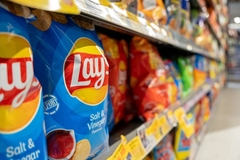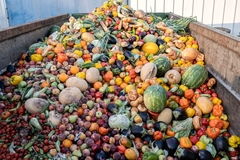“Slow Road to Zero”: Center for Biological Diversity slams US grocery sector for lack of food waste oversight
26 Nov 2019 --- Seven of the ten largest US grocery chains still have not taken the first step of making a commitment to zero waste, and while there have been some advances in tracking how much food is donated, the total volume of wasted food across the grocery sector remains untracked. These are the key findings from a recent “report card” on US supermarkets’ food waste strategies, issued by the nation’s Center for Biological Diversity. A significant contributor to food waste pinpointed by the organization are the “cosmetic standards” set by supermarkets, which propagate the disposal of “ugly” but edible produce. Moreover, the report underscores a dearth in information publicly disclosed by supermarkets regarding wasted produce.
“US consumers have become increasingly concerned with the economic and environmental costs of food waste. Based on our report, we are optimistic the grocery industry is starting to take it more seriously too. It is important that the food waste problem is addressed with systemic solutions and not just pushed back onto individual consumers,” Dr. Jennifer Molidor, Senior Food Campaigner at the Center for Biological Diversity, tells FoodIngredientsFirst.

“In spite of the growing awareness about the catastrophic effects of food waste, there is a lack of transparency – in the grocery industry, particularly. Consumers aren’t able to know precisely how big the problem is,” she adds.
In the report entitled Slow Road to Zero: A Report Card on US Supermarkets’ Path to Zero Food Waste, the Center for Biological Diversity ranks the following grocery chains on the basis of a letter scoring system:
A: Kroger, Walmart and Ahold Delhaize USA are the only three grocery chains to publicly commit to zero food waste by 2025, and all have prioritized tracking food waste and prevention.
B: Aldi, Target and Whole Foods have made commitments that are less ambitious than zero waste by 2025 and have begun implementing prevention strategies and tracking that are not yet company-wide or publicly reported.
C: Albertsons has some food-waste reduction strategies in place but has yet to make a clear, company-wide commitment to zero waste by 2025, publicly report food waste data or implement more effective prevention measures.
D: Costco, Publix and Trader Joe’s lag behind much of the grocery industry by lacking public commitments, transparent data tracking and comprehensive prevention strategies.
“We looked at company websites, corporate sustainability reports, news reports, promotional materials and other publicly available data. We also reached out to each supermarket directly to gather more information from company representatives. Some companies were responsive to requests for more information, others were not. We made every effort to include all available, relevant information,” notes the Center for Biological Diversity
FoodIngredientsFirst has reached out to the ranked grocery chains.
 Due to a lack of transparency, consumers are unable to grasp the severity of food waste, notes Dr. Molidor.Drivers of food waste
Due to a lack of transparency, consumers are unable to grasp the severity of food waste, notes Dr. Molidor.Drivers of food waste
The volume of food waste in the US is hard to comprehend, states the Center for Biological Diversity. It has been estimated that on a daily basis the country’s waste could fill a 90,000-seat college stadium. Furthermore, businesses that serve or sell food are responsible for 40 percent of food waste in the US, with retailers accounting for more waste than restaurants or foodservice providers.
Food waste in the grocery sector starts with what’s left on farms, in part due to cosmetic standards set by supermarkets, unutilized seasonal bumper crops, or misdirected ordering and purchasing practices, the organization outlines. In the past, it has been reported that 7 percent of food produced is wasted at the farm level. The non-profit cites a recent report published in Resources, Conservation and Recycling that suggests that up to 33.7 percent of crops may be left at the farm level.
In stores, companies stock shelves full of perishable, difficult to transport, and out-of-season food to feed the “unsustainable perception of endless abundance,” the report outlines. This leads to unnecessary spoilage due to overstocking. Using misleading labels instead of standard date labels also increases food waste.
The report highlights that while several companies share donation and recycling data, only two shared total volume that reflected what stores are doing to prevent food waste throughout their operations. “The amount of food donated to hunger relief efforts may sound impressive, but without the context of total food waste volume and prevention data, there’s no way for the public or the company to track the effectiveness of waste-reduction programs,” asserts the Center for Biological Diversity.
“This knowledge gap can be addressed by sharing specific data on total volume of food waste to shopper support mechanisms like standardizing date labeling. One way the industry can add to its transparency and better track its progress is to share actual data on food waste prevention, rather than just claiming to be fighting food waste. Another strategy is to focus on prevention strategies over donation,” notes Dr. Molidor.
Recommendations for streamlining food management Focusing on donation and recycling programs, instead of prevention and zero-waste commitments, is key.
Focusing on donation and recycling programs, instead of prevention and zero-waste commitments, is key.
The Center for Biological Diversity is urging “gatekeeper” grocery stores to implement programs that involve better ordering practices, clearer date labels, improved tracking and distribution technology, promotion of imperfect produce, and minimizing daily waste of meat and dairy.
“The grocery industry still needs greater accountability, commitment to specific, time-based policies to reduce food waste upstream and throughout the supply chain, and detailed strategies across sectors to make zero food waste a realistic goal,” asserts the organization.
Maintaining the status quo by focusing on donation and recycling programs, instead of prevention and zero-waste commitments, diverts attention from the environmental costs of wasted food and the systemic change needed to address them, the non-profit further states.
Integrating smartphone tech with food waste management strategies, US supermarket chain Meijer is piloting the Flashfood app in some of its stores in a bid to reduce food waste this month. Customers are able to use the app to purchase food – including meat, produce, seafood, and deli and bakery products – nearing its best-buy date at up to 50 percent off. The purchased food will be stored in a refrigerator or storage rack located in the front of each of the participating Metro Detroit supercenters until picked up by the customer.
In Europe, last October, social disrupter Too Good To Go released an app allowing consumers to purchase a “Magic Box” with a surprise assortment of food products from participating stores that would have otherwise been thrown away. A study conducted at Dutch Wageningen University and Research (WUR) found that the three main drivers for using the app were reducing food waste, the surprise element of the boxes’ contents and saving money.
“With the best companies, we’ve had some good conversations. We plan to track and monitor their progress annually and continue to report on this issue. Our scope is also evolving – solutions to the food waste crisis are interrelated with the role of labor and workers. The industry needs trained staff, not just technology, to implement long-term solutions. We intend to spotlight the waste-labor connection in the future among other issues,” concludes Dr. Molidor.
By Benjamin Ferrer












